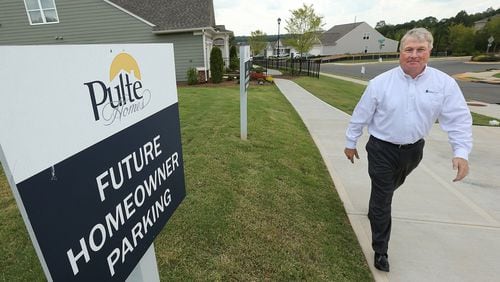Top 10 builders in metro Atlanta
1 DR Horton-Crown
2 Century Communities of Georgia
3 Ashton Woods Homes
4 Wilson Parker Homes
5 Lennar
6 Pulte Home Corp.
7 Smith Douglas Homes
8 Rocklyn Homes
9 Ryland Group
10 John Wieland Homes
Source: ViaSearch
Market Share for the Top 10 Atlanta builders, in number of units built
2005: 22%
2006: 22%
2007: 24%
2008: 29%
2009: 21%
2010: 25%
2011: 30%
2012: 32%
2013: 36%
2014: 39%
2015: 44%
Source: ViaSearch
In its heyday, the homebuilding industry in metro Atlanta was a mix of national companies, regional builders and pickup-truck entrepreneurs, all feasting off a growing pie.
These days the pie is a lot smaller, and the bigger players have a lot more of it.
In the past decade, the share of construction by just the top 10 builders has doubled – from 22 percent to 44 percent. The shift reflects the effects of a brutal shakeout that left a lasting mark.
In its wake is a more considered, conservative approach to development: There aren’t thousands of small builders each making small decisions that add up to a frenzy of overbuilding. And big builders — many of them publicly traded — tend not to make rash decisions.
“Consolidation has certainly had an impact,” said Edward Woodland, division president for Ryland Homes. “There are not a lot of small local builders around. They just didn’t make it through the recession.”
As the California-based company chooses sites for development and markets its homes, the competition starts to look familiar, he said.
“We bid against these guys every day,” Woodland said. “The same five to seven characters.”
John Hunt, president of ViaSearch, an Atlanta-based research and analysis company, said the barriers to entry were pretty low a decade ago. All it seemed to take was a truck and a friend at a local bank to loan you the money to buy a lot and put up a house.
Metro Atlanta was at the top – or near it – in homebuilding, and the growth supported a welter of builders.
“Atlanta used to be uniquely fragmented with many smaller ‘pickup truck’ builders,” Hunt said. “Much less so today.”
The market virtually collapsed in 2008-09. Spec homes sat empty and lots left unfinished.
Many builders fell into bankruptcy or just left the business. Just as critically, dozens of local banks failed and the remaining lenders cut off the spigot.
By the time the market hit bottom, Atlanta had gone from 3,500 builders to fewer than 700, Hunt said.
Bigger players had the resources to ride out the crash, but they struggled, too. For instance:
— Ryland closed on 1,207 homes in 2006, but only 178 in 2011. Last year the number bounced to 500, Woodland said. “Our staff went from over 200 in 2006 to about 75 now. We are much leaner organization in everything we do now.”
— Atlanta-based Pulte had revenue of more than $14 billion in both 2005 and 2006. Sales plunged to less than $4 billion in 2011. It was $5.7 billion last year.
— Atlanta’s biggest builder, Texas-based DR Horton, had revenue of $15.1 billion in 2006, but only $3.7 billion three years later. Last year, revenue was $8 billion.
Permits rebound
Building permits for single-family homes in metro Atlanta are on pace to hit about 20,000 this year. That’s well off the peak of more than 60,000 in 2005, but a whole lot higher than the 5,421 permits issued in 2009, according to the Census Bureau.
“We have come a long way,” said Jeff Hoza, division president of Beazer Homes.
The Atlanta company weathered a serious crisis but is emerging with confidence because the local economy enjoys solid and improving fundamentals, he said.
“Employment growth has been steady – about 3 percent in the past year. And the quality of life – it is a great place to live.”
The market’s strength is uneven, however. Gone are the days when just about any tract of virgin land in the suburbs would draw a builder’s attention.
The players now see divisions in the market – both geographic and demographic.
“We see strength around the northern suburbs, but we also see in-town markets, too, doing very well,” Hoza said.
Most of the suburban growth is pegged to school systems, he said.
“A lot of our success is because we are focused on high-performing school districts, especially in north Fulton, in Forsyth and in Gwinnett.”
In-town growth seems to depend on people with different priorities, Hoza said. “The in-town is driven by millennials and professionals. And in my opinion, in-town buyers like living in town. They are younger, they are professionals.”
The market is unpredictably bumpy in other ways, too.
At one well-sited townhome development, “if we’d put up a sign with the price a year ago, we would have had to repaint it about five times,” said Michael Malloy, vice president at Ashton Woods Homes, a Roswell-based builder. “There are rising costs for land, for materials and labor.”
Average prices are up roughly 5 percent from a year ago, but the increase is much higher in some areas – especially where there has been a shortage of homes for sale.
That scarcity makes it harder for some people to sell their homes and move, but it also means higher selling prices for the houses that are on the market, Malloy said.
New homes needed
Big builders that can raise capital see it as a good time to bring new homes to the market.
“Demand is to a high point and supply is historically low – supply is so constrained,” said Casey Hill, division president of Pulte Homes.
A number of factors hold down inventory. Some homeowners won’t sell because they are still “underwater,” owing more on their mortgages than their homes can fetch in the market.
Others were convinced during the downturn that selling their house was not possible, while others might not realize how much the value of their home has grown since the turnaround, Hill said.
“I think a lot of owners do not understand how much equity they have.”
Construction had oversized importance to the economy in the bubble days, and it is still crucial in many ways – the number of jobs directly and indirectly related to building, the ripple effect of the spending, the “wealth effect” on homeowners.
And building has decidedly picked up, as evidenced by the 273 percent rise in building permits since the market bottomed in 2009.
But construction is still nowhere near the peak: permits this year are 67 percent below the 2005 level.
Most builders say they aren’t anxious for a return to the hysterical over-building of a decade ago. But somewhere in between that and the current pace would be nice, they say, and they are a little impatient to see things heat up a bit more.
“I think the general consensus was that people thought it would get a lot better,” Ryland’s Woodland said. “And it’s good, but I don’t think it’s a lot better.”
About the Author






